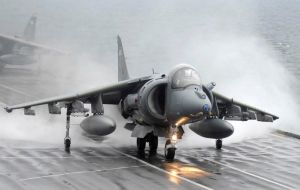MercoPress. South Atlantic News Agency
Falklands’ combat tested Harrier celebrates 40th birthday
 The Harrier vertical take off first flew on 28 December 1967
The Harrier vertical take off first flew on 28 December 1967 The British designed and manufactured vertical take off Harrier which saw its first combat operations during the Falkland Islands campaign in 1982 this week, Thursday 23 July celebrated its fortieth birthday.
Over 400 RAF and Navy personnel who have worked with the Harrier jump jet over the last 40 years gathered at RAF Wittering, the 'Home of the Harrier', for the celebration.
Coming into service with the RAF in 1969, the Harrier was a great technological leap forward, being the world's first successful vectored thrust jet offering vertical take-off and landing.
To celebrate the achievements of the jet over the last 40 years, key figures in its proud history met to share stories and toast the fighter at a gala dinner at RAF Wittering.
Those attending included the designers and first test pilots, those who flew and maintained the Harrier in the Cold War and the first combat operations in the Falklands campaign, and members of No 1 (Fighter) Squadron whose recent return to RAF Cottesmore marked the end of five years of operations in Afghanistan for Joint Force Harrier.
The origins of the plane go back to 1957 when Sir Sydney Camm, Ralph Hooper and Stanley Hooker first began experimenting with the innovative vectored thrust turbofan engine.
This was refined and developed and the first incarnation of the jet as we know it today was the Hawker Siddeley Harrier GR1 which first flew on 28 December 1967 and entered service with the RAF on 1 April 1969.
Since then several upgrades and modifications have been made and the plane has always been a favourite with pilots.
One such pilot was Sir Peter Squire, former Chief of the Air Staff. Sir Peter led 1 (Fighter) Squadron during the Falklands campaign in 1982. He first flew the Harrier in 1975 and has flown all major variants of Harrier since.
“I always wanted to fly Harrier. It's THE aeroplane - it was beautifully harmonised. The Hunter was a joy to handle, but the Harrier did it all” did Sir Peter Squire.
Also at the gala dinner was Duncan Simpson who trained the first RAF instructors for the Harrier in May 1969. Rather than a challenge he said that getting pilots used to the revolutionary new plane was relatively simple:
“It was easy”, said Mr Duncan. “We trained four instructors using a system we had devised for the Kestrel programme. We must have got it right because it is still much the same syllabus today!”
However, the longevity of Harrier's in-service life has shocked even some of its most ardent supporters: “I'm amazed the Harrier's still going strong!” Mr Duncan said.
There is every chance that the plane will continue to serve Britain until its 50th birthday as there are ten more years of operational service planned for the plane before it is withdrawn completely and replaced by the Joint Combat Aircraft. (MOD)




Top Comments
Disclaimer & comment rulesCommenting for this story is now closed.
If you have a Facebook account, become a fan and comment on our Facebook Page!